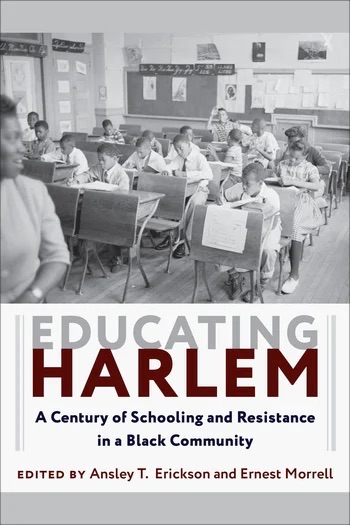Over the course of the twentieth century, education was a key site for envisioning opportunities for African Americans, but the very schools they attended sometimes acted as obstacles to black flourishing. Educating Harlem brings together a multidisciplinary group of scholars to provide a broad consideration of the history of schooling in perhaps the nation’s most iconic black community.
The volume traces the varied ways that Harlem residents defined and pursued educational justice for their children and community despite consistent neglect and structural oppression. Contributors investigate the individuals, organizations, and initiatives that fostered educational visions, underscoring their breadth, variety, and persistence. Their essays span the century, from the Great Migration and the Harlem Renaissance through the 1970s fiscal crisis and up to the present. They tell the stories of Harlem residents from a wide variety of social positions and life experiences, from young children to expert researchers to neighborhood mothers and ambitious institution builders who imagined a dynamic array of possibilities from modest improvements to radical reshaping of their schools. Representing many disciplinary perspectives, the chapters examine a range of topics including architecture, literature, film, youth and adult organizing, employment, and city politics. Challenging the conventional rise-and-fall narratives found in many urban histories, the book tells a story of persistent struggle in each phase of the twentieth century. Educating Harlem paints a nuanced portrait of education in a storied community and brings much-needed historical context to one of the most embattled educational spaces today.
- Table of Contents
- Acknowledgments
- Abbreviations
- Introduction, by Ansley T. Erickson and Ernest Morrell
- Part I. Debating What and How Harlem Students Learn in the Renaissance and Beyond
- 1. Schooling the New Negro: Progressive Education, Black Modernity, and the Long Harlem Renaissance, by Daniel Perlstein
- 2.“A Serious Pedagogical Situation”: Diverging School Reform Priorities in Depression Era Harlem, by Thomas Harbison
- 3. Wadleigh High School: The Price of Segregation, by Kimberley Johnson
- Part II. Organizing, Writing, and Teaching for Reform in the 1930s Through 1950s
- 4. Cinema for Social Change: The Human Relations Film Series of the Harlem Committee of the Teachers Union, 1936–1950, by Lisa Rabin and Craig Kridel
- 5. Bringing Harlem to the Schools: Langston Hughes’s The First Book of Negroes and Crafting a Juvenile Readership, by Jonna Perrillo
- 6. Harlem Schools and the New York City Teachers Union, by Clarence Taylor
- Part III. Divergent Educational Visions in the Activist 1960s and 1970s
- 7. HARYOU: An Apprenticeship for Young Leaders, by Ansley T. Erickson
- 8. Intermediate School 201: Race, Space, and Modern Architecture in Harlem, by Marta Gutman
- 9. Black Power as Educational Renaissance: The Harlem Landscape, by Russell Rickford
- 10. “Harlem Sophistication”: Community-based Paraprofessional Educators in Central Harlem and East Harlem, by Nick Juravich
- Part IV. Post–Civil Rights Setbacks and Structural Alternatives to Public Schooling
- 11. Harlem Schools in the Fiscal Crisis, by Kim Phillips-Fein and Esther Cyna
- 12. Pursuing “Real Power to Parents”: Babette Edwards’s Activism from Community Control to Charter Schools, by Brittney Lewer
- 13. Teaching Harlem: Black Teachers and the Changing Educational Landscape of Twenty-First Century Central Harlem, by Bethany L. Rogers and Terrenda C. White
- Conclusion, by Ernest Morrell and Ansley T. Erickson
- Contributors
- Index

